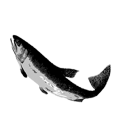Annika Walters was part of a team of researchers that developed a vulnerability index incorporating a stream ecosystem’s natural sensitivity to alterations and its exposure to anthropogenic stressors, such as well pads, urbanization and agriculture. Streams with the highest sensitivity and exposure to stressors may be most vulnerable to unconventional oil and gas (UOG) development.
The team of academic, USGS, and private-sector researchers used Geographic Information System technology to compute stream vulnerability to UOG development in six shale plays (Bakken, Barnett, Fayetteville, Hilliard-Baxter-Mancos, Marcellus and Utica, Niobrara-Mowry) across the contiguous U.S.
Vulnerability varied across plays due to climatic, geologic and human caused differences. Overall, streams in the Niobrara-Mowry Play of eastern Wyoming proved to be the most vulnerable to UOG development, but streams in all regions have the potential to be affected by UOG. Those in the drier regions of the western US (Niobrara-Mowry, Hilliard-Baxter-Mancos, and Bakken) tended to be more sensitive to stressors due to low annual average precipitation and extensive grassland cover in their watersheds. In contrast, streams in the Barnett and Marcellus-Utica were naturally sensitive from more erosive soils and steeper slopes in their watersheds, as well as experiencing areas with greater UOG development and urbanization. Streams in the Fayetteville and Barnett regions were vulnerable due to ongoing exposure to human development in watersheds.
The indices developed in this paper can be used to identify streams where biota are particularly vulnerable and then help prioritize stream protection and monitoring efforts. Resource managers can also use these findings to guide local development activities to help reduce potential environmental effects.
The paper “Stream vulnerability to widespread and emergent stressors: a focus on unconventional oil and gas” is published in PLOS ONE, which is an open-access, peer-reviewed scientific journal and can be downloaded free of charge at http://journals.plos.org/plosone/article?id=10.1371/journal.pone.0137416.


